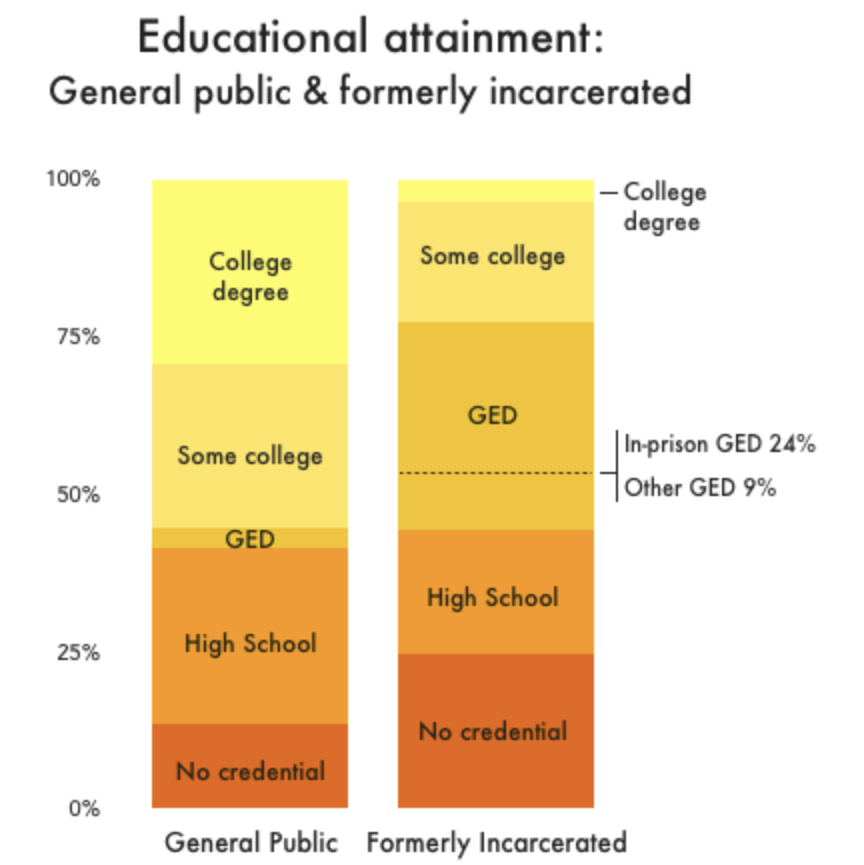This year, I had the opportunity to take a class entitled “Prison, Religion, and Social Justice,” as a second year at Emory University. As the child of a formerly incarcerated individual, I have had the special opportunity throughout the course of calling my dad and hearing his opinions and thoughts on different topics from class, always framed by his lived experience with the carceral system. This blog draws upon outside academic sources to give a broad picture of mass incarceration in our current landscape, but weaves throughout these academic sources a conversation I had with my dad about his relationship with the carceral system and the American educational system.
My dad, Josh Gordon, is the son of two school teachers, born and raised in rural South Georgia. He started working with cars at the age of 14, and by his sophomore year of highschool had two separate jobs building motors at a factory and working as a mechanic at a local shop in town. Despite having educators as parents, school was never his priority, and secondary education was never presented to him as necessary, or even a tool that could improve his life. He’d been, like so many students in the American education system, funnelled into a track in school that set him up for a working class, skills based occupation, and didn’t emphasize secondary education. There’s nothing inherently wrong with this path, but he does express regret at the fact that he wasn’t encouraged by teachers or guidance counsellors to pursue secondary education in addition to his education as a mechanic.

One aspect of this class was partnering with a member of the Atlanta community working towards justice reform within the prison system in some aspect. I was put into a group partnering with Patrick Rodriguez, who was formerly incarcerated, and whose work focuses primarily on increasing access to secondary education for formerly incarcerated and incarcerated folks. Patrick serves as the campaign manager for Beyond the Box, an organization with the primary goal of removing the “box” requiring applicants to indicate whether or not they have been incarcerated in the past. Oftentimes, checking this box can result in applications being rejected, or at the very least creates greater obstacles for formerly incarcerated people who are seeking secondary education. This idea of moving beyond the box, and examining applications based on a wholistic evaluation of a person rather than allowing past actions to dictate an individual’s future is a key part of humanizing those affected by the carceral system and shifting societal views of what a “criminal” and their lives looks like.
It wasn’t until I met Patrick Rodriguez and learned about the work he is doing with Beyond the Box that I realized just how significant a role education plays in mass incarceration, and I began discussing this more with my dad. Data shows that of the 5+ million formerly incarcerated individuals living in the United States, less than 5% have a college degree. In a study conducted by the Prison Policy Initiative, it was found that those who have faced incarceration are “twice as likely to have no high school credential at all,” in comparison to the general public. A report published by the US Department of Education revealed that “inside our prisons, 19% of adult inmates are illiterate, and up to 60% are functionally illiterate,” compared to 4% and 23% respectively, in the general population.

These numbers should serve as more than simply shocking statistics; they should be clear signals to us that our education system as it is currently funded and conducted is failing. And when our education fails us, it has real world impacts. To put it simply, in the words of my dad, “The people that go to college are not the people that go to jail, generally speaking. And the people that go to jail are not the people that go to college.” When I asked him if he thought a secondary degree would have prevented his incarceration, my dad answered decisively: “Yes, absolutely. If I would’ve chosen that, No. I would not have gone to jail. Education leads to making better choices and doing better things. You’re around a different set of people, entirely. And if you are not pursuing education, whatever that looks like for you, you will not have access to the same people and choices. You’re set apart on a totally different path.”
There is a major disconnect between those who have access to higher education and those who are affected by the carceral system, and the data shows us this time and time again. We cannot ignore the impact that education, and the lack of funding for quality education, plays in America’s mass incarceration problem. This brings us to the phenomena which has been coined the “school to prison pipeline.” In an article by the Prison Policy Initiative, the school to prison pipeline is described as “punitive practices in schools and neighborhoods that funnel [students] out of school and into juvenile and criminal justice system involvement.” While this description focuses primarily on systems of punishment within school, it can be argued that a large part of this trend is a result of underfunding and lack of resources, particularly for marginalized students who are already facing higher rates of policing and greater risk of incarceration. An NAACP report, “Misplaced Priorities,” investigating the ties between education and mass incarceration shows that “while funding for higher education between 1987 and 2007 grew by just 21 percent, corrections funding grew by 127 percent.” When we acknowledge the evidence earlier pointing towards a lack of education leading to incarceration, paired with this trend of a lack of investment in education, and yet a massive increase in corrections funding, it is not surprising that incarceration rates have only steadily increased in the past decades.
What could an alternative future look like? Imagine if those statistics were reversed, and rather than investing funds into increasing the span of the carceral system, funds were redirected towards education. What if instead of building new prisons, we saw the state investing in public schools: building new STEM facilities for students in low income areas, providing greater access to after school care and activities so that parents could work without worrying about their children’s safety, even things as simple as providing new textbooks and other creative learning resources for teachers. What if we invested in our public school teachers so that they can invest in our children? This future is not unattainable.
This is the future of prison abolition. Prison abolition can feel like a scary idea that feels unrealistic and unachievable. But I think framing it in the context of divestment and redirecting funds towards greater access to education is one of the ways that abolitionists and advocates of prison reform can make the process feel more realistic and achievable, and less daunting to the general public. The idea that education is a powerful, and overwhelmingly positive, tool is not a controversial one. When I initially discussed prison abolition with my dad, even as someone who has been directly impacted negatively by the system, he was hesitant to voice support for a complete eradication of the prison system. However, almost immediately after I framed abolition as a transition taking place through divestment from prisons and reinvestment in community care, such as education, his perspective changed. The language of care stuck out to him, and he explained to me his basic philosophy on education as a tool to reduce incarceration: “In America, we’re raising people who are uneducated, with just enough resources to cause danger, but not enough to take care of themselves. It’s human nature… we’re gonna take care of ourselves to the best of our ability. And the more educated we are, the better we can do that, generally, as a rule. The better decisions you’re gonna make.” This idea of “crime” as a direct result of our need to take care of ourselves and our loved ones being at odds with a lack of resources and education to do so is a key shift in perspective for abolitionists. Education then becomes not only a tool to prevent and initiate the end of mass incarceration, but also a healing tool that provides a hope for a more just future.
We’re gonna take care of ourselves to the best of our ability. And the more educated we are, the better we can do that…
Josh Gordon
This idea of using concepts of healing and community care to frame abolition is not a new one. Abolitionists such as Mariame Kaba and the Black, queer led abolitionist group Harriet’s Apothecary both envision futures where justice is an act of community care, and emphasize the fact that prison abolition goes beyond tearing down physical buildings, or removing systemic practices. It is about relearning how to care for each other in a just and fair way. In my dad’s case, his vision for community care begins with education, and giving people the resources necessary to know how to take care of themselves, and eventually their community as well.
Leave a Reply